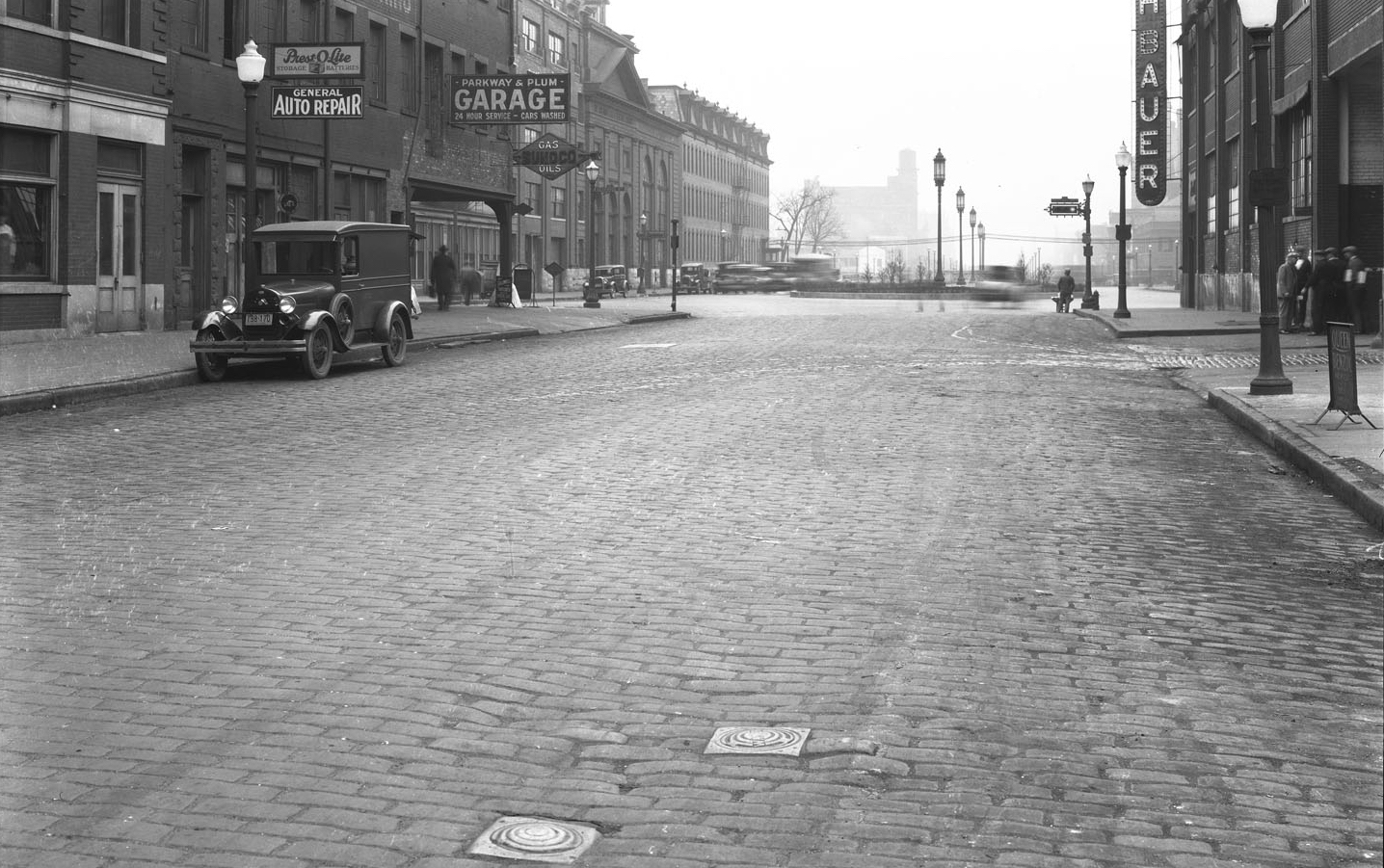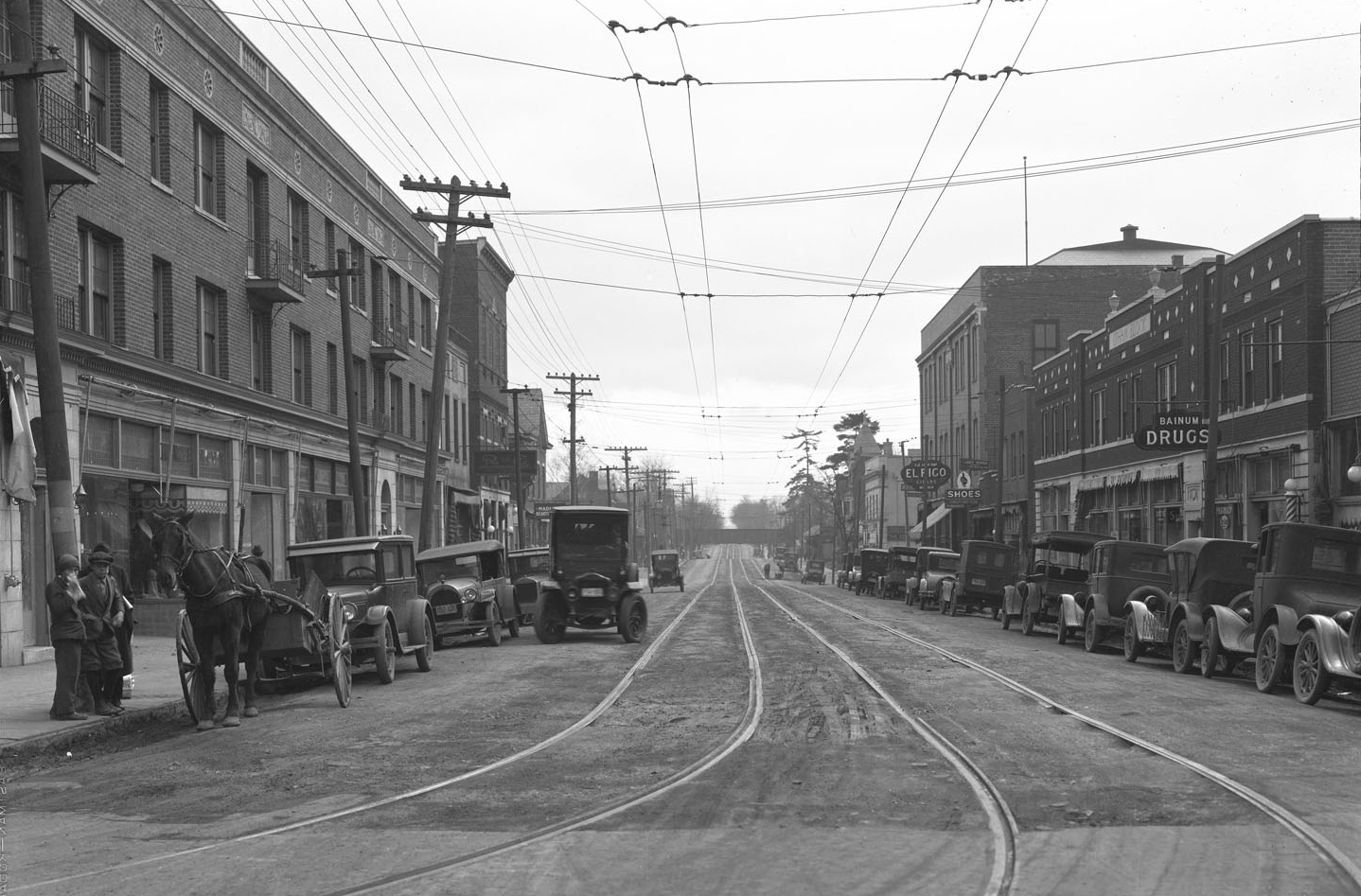Over the years, Cincinnati’s streets have been named, renamed, abandoned, and vacated. The origin of some of our street names is lost in the mists of time and mythology. I looked at some fun examples back in March, and here are a few more attempts to sort the facts from the folderol.

Image digitized by University of Cincinnati Archives & Rare Books Library
Now That’s Plumb Curious
On the very earliest Cincinnati maps, today’s Plum Street is labeled as Filson Street, honoring the first local surveyor (who coined the settlement name Losantiville), John Filson. By 1802, however, Filson Street had become (mostly) Plumb Street. There was enough confusion on this and other street names that City Council officially named the downtown streets on February 12, 1814, codifying that spelling, with a “B” at the end. One hundred years later, The Cincinnati Post [November 25, 1914] claimed that it was “Plumb” Street “because other streets were platted plumb, or square, with it.” While this may have been the case, there does not appear to be a contemporary record to support this theory. To the contrary, it seems that Cincinnati’s streets were “plumbed” westward from Broadway, originally known as Eastern Row. Additionally, it must be noted that the sweet purple fruit was known equally well as “plums” or “plumbs” up to around 1850. Whether by coincidence or not, all city maps after 1850 refer to Plum Street.
Beware the Indian Maiden!
As a useful rule of thumb, if you run across an origin story featuring an otherwise unidentified Indian Maiden, consider that legend—no matter the source—to be unmitigated poppycock. For example, The Post [November 24, 1914] claimed that Race Street got its name because two Indian braves raced down that primeval avenue to win the hand of a beautiful Indian Maiden. In reality, Race Street (and Vine, Walnut, Sycamore, etc.) was named by surveyor Israel Ludlow when he created to first official plat of the town. Ludlow used street names borrowed from Philadelphia. Be likewise suspicious of nostalgic old ladies. Mrs. Mary Lawton, aged 80, told The Enquirer [June 23, 1929] that her own father, Nicholas Hoeffer, named Race Street after a racing track he owned at Washington Park. Not so, Mrs. Lawton, not so.
Don’t Touch That Name!
Cincinnati street names accrue sentimental ties in curious ways. In 1860, Rosetta Cobb, an elderly Irish Immigrant, sold off a plot of land in the ravine between Clifton and Clifton Heights. She filed a plat with the county naming all the subdivision’s streets for her daughters: Laura, Eveline, Christiana, and Julia Ann. Over the years, property sales and redevelopment eliminated all of those streets except for Julia Ann. In 1992, the owners of Clifton Colony Apartments, located at the end of Julia Ann Street, petitioned the City of Cincinnati to change the name of the street because no one could find their apartment buildings.
The city reasoned that Julia Ann Cobb and her mother were long past caring. Rosetta Cobb had gone to her reward in 1872, and Julia Ann had married Franklin Underwood in 1855 and moved to Memphis, where she remained for the rest of her life. Hearing no objections, the city renamed Julia Ann Street to Clifton Colony Drive. One year later, Ronald Meyer, the city official in charge of street names, got an irate letter from a woman named Julia Ann, demanding Cincinnati change that street name back! Her parents—apparently no relation to the Cobb family—had named their daughter after that street and she considered it to be her very own.
No Glory for Secretaries
If you can find them, Cincinnati named two streets to honor secretaries. Amthauer Street in Fairmount is sandwiched between Tremont and Harrison and runs eastward from Adler to Pinetree. Until 1908, that little lane was named Spruce Street, but was changed to honor Louise Amthauer, a secretary in the city clerk’s office, during a wholesale street retitling by the Boss Cox machine. Ms. Amthauer was a dedicated Republican and later married the county GOP chairman. There is no signage for Amthauer Street and no pavement; it’s only a paper street. Peggie Lane in Lower Price Hill is at least paved, but also lacks signage. In 1956, Margaret “Peggie” Funk was a secretary in the City Engineer’s Office, and the City Engineer needed a name for the driveway abutting Oyler School. “Peggie” was brief, easy to spell, impossible to mispronounce, and didn’t conflict with any other names in the system. But the cheapskates couldn’t spring for a sign to recognize Ms. Funk.

Image digitized by University of Cincinnati Archives & Rare Books Library
Got You Under My Spell
Street names appear on street signs, obviously, but also on maps, directories, driver’s licenses, and mailing lists. Sometimes discrepancies arise. Copelen Street in Walnut Hills marks the location of Fireside Pizza in the old Company 16 Firehouse. In December 1930, The Post printed a “gotcha” story claiming the street sign was wrong because the city directory called it Copeland Street. The Post had to eat crow a few days later when Eugene Schellinger, city draughtsman, uncovered the 1855 ordinance naming that thoroughfare in honor of pioneering resident Isaac Copelen, an insurance magnate and distinguished Mason who once lived nearby. The newspaper got snookered again in 1964, complaining that Wolfangel Road in Anderson Township should be spelled “Wolfangle.” Tell that to the descendants of pioneer settler Gottfried Wolfangel!
Not so easy to explain were the manifold misspellings of Whetsel Avenue, honoring Madisonville farmer and military hero Henry Bramble Whetsel. That road winds through three political jurisdictions. In the mid-1990s, an observant commuter noticed the correct spelling on Cincinnati’s signs, but Madeira spelled it Wetsel and Hamilton County opted for Whetzel.
That’s No Lady, That’s a Surveyor!
Jo Williams, born 1981, is a British speed skater, while Jo Williams, born 1948 (now Dame Josephine Williams), is a British social worker. Neither of these ladies has anything to do with Jo Williams Street in Northside, which has been connecting Colerain Avenue and Blue Rock Road since 1853. “Jo” in this case is Joel Williams, one of Cincinnati’s earliest settlers. Williams competed with Israel Ludlow to draw up the official plat of Cincinnati. The town fathers chose Ludlow’s plan. Williams attempted to claim the Public Landing through a curious application of squatter’s rights, but lost in court. He was more successful as an innkeeper, real estate investor, and operator of Cincinnati’s first ferry.
A stint as a surveyor proved effective at getting a street named for you. Jo Williams’ nemesis, Israel Ludlow, is recognized by Clifton’s main drag, while (John) Filson Street, (Joseph) Gest Street, and (Eli) Elder Street honor other local surveyors.
Not All Streets Have Happy Endings
Few people give a thought to Northside’s Gulow Street, a short stretch of pavement with a few nondescript buildings and a parking lot, plus an odd-sounding name. The street honors the memory of August E. Gulow, a merchant tailor who kept a dry goods shop at Knowlton’s Corner for many years. The little byway had been known as Oak Street, but City Council changed the name to Gulow in 1870. By 1900, Mr. Gulow was slipping into insanity, distraught after two daughters died from tuberculosis. The family did all they could to keep the old man out of an institution, but on December 5, 1901, he grabbed a razor and repeatedly slashed his stomach. He died six days later and is buried at Spring Grove Cemetery. His name lives on in that little street.





Facebook Comments